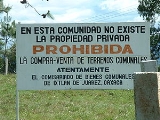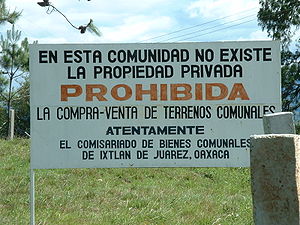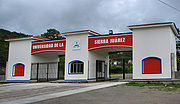
Ixtlán de Juárez
Encyclopedia
Ixtlán de Juárez is a town and municipality in the Mexican
state of Oaxaca
about 65 km north of the city of Oaxaca
on Federal Highway 175
towards Veracruz
.
It is part of the Ixtlán District
in the Sierra Norte de Oaxaca
region.
, is a small independent municipality). The Rincón does not include the town of Ixtlán or other communities on the main road. This remote and culturally homogeneous area is one of the most intensely indigenous in the whole of Mexico, and has therefore been the subject of considerable sociological study
. It is thought to have been founded in the latter half of the 15th century, by Zapotec
people from the region around Tarabundi and San Pedro Laduu (though there are also neolithic
remains in the area). The first settlers were probably warriors establishing a defensive outpost against Aztec
invaders. In 1859 Ixtlán was the site of a battle during the Reform War
between liberal and conservative forces. Some of the other communities in the municipality are probably several centuries older than the town of Ixtlán
San Pablo Guelatao
, the birthplace of Benito Juárez
, lies 4 km from the town of Ixtlán and at the time of his birth fell within its jurisdiction, so Juárez was baptised in the church of St Thomas in Ixtlán; hence his name has been added to that of the town (in 1824, however, Guelatao declared itself independent of Ixtlán, and it remains an independent municipality). The addition of Juárez's name serves the additional purpose of distinguishing the town from the many other Ixtláns in Mexico: the name is usually claimed to come from Aztec
words meaning "land of the maguey", and use of the maguey (otherwise known as the century plant) was widespread in pre-Columbian Mexico. An alternative proposed derivation is from Mixtec
words meaning "place of obsidian
", and the town uses a logo that depicts an object made of obsidian.
 Ixtlán is now a centre for eco-tourism. Its location, surrounded by cloud forest
Ixtlán is now a centre for eco-tourism. Its location, surrounded by cloud forest
and pine and oak woodlands (which are forested sustainably) gives it great natural landscape beauty, and the forests of the Sierra Juárez
mountains are claimed to be home to around 500 bird species and 6000 plant species.
Tours are operated from the village, and accommodation is available.
Hiking trails link it to neighbouring towns and villages in the Sierra Norte. It is accessible by the bus service that connects Oaxaca and Veracruz along Federal Highway 175. The land is held in common
, but for a time in the late 20th century, a Mexican national paper manufacturer held a concession to harvest its forests. However when the concession expired, the local communities denied the company any extensions and the forests are now managed communally in order to ensure that they are sustainable.
Principal agricultural crops in the municipality of Ixtlán are maize
and coffee
, with a small amount of land given over to sugarcane
and other crops. Fair trade
marketing has made a substantial difference to the coffee growers in this area.
 As a rural mountainous region, higher education had previously not been readily available to the populace. In April 2005 the government of the state of Oaxaca established the Universidad de la Sierra Juárez
As a rural mountainous region, higher education had previously not been readily available to the populace. In April 2005 the government of the state of Oaxaca established the Universidad de la Sierra Juárez
to help further the development and education of citizens in the Sierra Norte
region. Currently the university offers degrees in the fields of natural sciences, sociology
and humanities
. UNSIJ also encourages four core academic activities among its students, including: teaching, research, cultural enrichment, and promotion of regional development.
Mexico
The United Mexican States , commonly known as Mexico , is a federal constitutional republic in North America. It is bordered on the north by the United States; on the south and west by the Pacific Ocean; on the southeast by Guatemala, Belize, and the Caribbean Sea; and on the east by the Gulf of...
state of Oaxaca
Oaxaca
Oaxaca , , officially Estado Libre y Soberano de Oaxaca is one of the 31 states which, along with the Federal District, comprise the 32 federative entities of Mexico. It is divided into 571 municipalities; of which 418 are governed by the system of customs and traditions...
about 65 km north of the city of Oaxaca
Oaxaca, Oaxaca
The city and municipality of Oaxaca de Juárez, or simply Oaxaca, is the capital and largest city of the Mexican state of the same name . It is located in the Centro District in the Central Valleys region of the state, in the foothills of the Sierra Madre at the base of the Cerro del Fortín...
on Federal Highway 175
Mexican Federal Highway 175
Mexican Federal Highway 175 is a Federal Highway of Mexico....
towards Veracruz
Veracruz
Veracruz, formally Veracruz de Ignacio de la Llave officially Estado Libre y Soberano de Veracruz de Ignacio de la Llave , is one of the 31 states that, along with the Federal District, comprise the 32 federative entities of Mexico. It is divided in 212 municipalities and its capital city is...
.
It is part of the Ixtlán District
Ixtlán District, Oaxaca
Ixtlán District is located in the northeast of the Sierra Norte region of the State of Oaxaca, Mexico.The district includes 26 municipalities, bringing together a total of 161 settlements which at the 2000 census had between them 40,218 inhabitants, the majority of them indigenous Zapotec...
in the Sierra Norte de Oaxaca
Sierra Norte de Oaxaca
La Sierra Norte de Oaxaca is a heavily-wooded region in the state of Oaxaca, Mexico.It is 62 km from the city of Oaxaca on Federal highway 175, heading east towards Tuxtepec....
region.
Municipality of Ixtlán
The municipality of Ixtlán de Juárez includes the town, and in addition the settlements of San Juan Yagila, Santa Cruz Yagavila, Santa María Yahuiche, Santa María Zoogochi, Santiago Teotlasco, Santo Domingo Cacalotepec, San Gaspar Yagalaxi, San Miguel Tiltepec, Santa María Josaa, La Luz, La Josefina and La Palma. The population of the town in the 2005 census was 2,479, and of the entire municipality, 7,188. Other than the town of Ixtlán, none of the settlements have as many as a thousand inhabitants.Rincón de Ixtlán
The Rincón de Ixtlán is an area largely within the municipality of Ixtlán de Juárez. It comprises nine communities, eight of them within the municipality of Ixtlán (the ninth, San Pedro YaneriSan Pedro Yaneri
San Pedro Yaneri is a town and municipality in Oaxaca in south-western Mexico. The municipality covers an area of 79.1 km².As of 2005, the municipality had a total population of 943, of whom 807 spoke some indigenous language....
, is a small independent municipality). The Rincón does not include the town of Ixtlán or other communities on the main road. This remote and culturally homogeneous area is one of the most intensely indigenous in the whole of Mexico, and has therefore been the subject of considerable sociological study
History
The town of Ixtlán existed before the Spanish Conquest of MexicoSpanish conquest of Mexico
The Spanish conquest of the Aztec Empire was one of the most important campaigns in the Spanish colonization of the Americas. The invasion began in February 1519 and was acclaimed victorious on August 13, 1521, by a coalition army of Spanish conquistadors and Tlaxcalan warriors led by Hernán Cortés...
. It is thought to have been founded in the latter half of the 15th century, by Zapotec
Zapotec civilization
The Zapotec civilization was an indigenous pre-Columbian civilization that flourished in the Valley of Oaxaca of southern Mesoamerica. Archaeological evidence shows their culture goes back at least 2500 years...
people from the region around Tarabundi and San Pedro Laduu (though there are also neolithic
Neolithic
The Neolithic Age, Era, or Period, or New Stone Age, was a period in the development of human technology, beginning about 9500 BC in some parts of the Middle East, and later in other parts of the world. It is traditionally considered as the last part of the Stone Age...
remains in the area). The first settlers were probably warriors establishing a defensive outpost against Aztec
Aztec
The Aztec people were certain ethnic groups of central Mexico, particularly those groups who spoke the Nahuatl language and who dominated large parts of Mesoamerica in the 14th, 15th and 16th centuries, a period referred to as the late post-classic period in Mesoamerican chronology.Aztec is the...
invaders. In 1859 Ixtlán was the site of a battle during the Reform War
Reform War
The Reform War in Mexico is one of the episodes of the long struggle between Liberal and Conservative forces that dominated the country’s history in the 19th century. The Liberals wanted a federalist government, limiting traditional Catholic Church and military influence in the country...
between liberal and conservative forces. Some of the other communities in the municipality are probably several centuries older than the town of Ixtlán
San Pablo Guelatao
San Pablo Guelatao
San Pablo Guelatao is a town in the Mexican state of Oaxaca and the seat of the municipality of Guelatao de Juárez, about 55 km north of the city of Oaxaca...
, the birthplace of Benito Juárez
Benito Juárez
Benito Juárez born Benito Pablo Juárez García, was a Mexican lawyer and politician of Zapotec origin from Oaxaca who served five terms as president of Mexico: 1858–1861 as interim, 1861–1865, 1865–1867, 1867–1871 and 1871–1872...
, lies 4 km from the town of Ixtlán and at the time of his birth fell within its jurisdiction, so Juárez was baptised in the church of St Thomas in Ixtlán; hence his name has been added to that of the town (in 1824, however, Guelatao declared itself independent of Ixtlán, and it remains an independent municipality). The addition of Juárez's name serves the additional purpose of distinguishing the town from the many other Ixtláns in Mexico: the name is usually claimed to come from Aztec
Aztec
The Aztec people were certain ethnic groups of central Mexico, particularly those groups who spoke the Nahuatl language and who dominated large parts of Mesoamerica in the 14th, 15th and 16th centuries, a period referred to as the late post-classic period in Mesoamerican chronology.Aztec is the...
words meaning "land of the maguey", and use of the maguey (otherwise known as the century plant) was widespread in pre-Columbian Mexico. An alternative proposed derivation is from Mixtec
Mixtecan languages
The Mixtec language, actually multiple languages, belong to Otomanguean language family of Mexico, and are closely related to the Trique and Cuicatec languages. They are spoken by over half a million people. Identifying how many Mixtec languages there are in this complex dialect continuum poses...
words meaning "place of obsidian
Obsidian
Obsidian is a naturally occurring volcanic glass formed as an extrusive igneous rock.It is produced when felsic lava extruded from a volcano cools rapidly with minimum crystal growth...
", and the town uses a logo that depicts an object made of obsidian.
Economy

Cloud forest
A cloud forest, also called a fog forest, is a generally tropical or subtropical evergreen montane moist forest characterized by a persistent, frequent or seasonal low-level cloud cover, usually at the canopy level. Cloud forests often exhibit an abundance of mosses covering the ground and...
and pine and oak woodlands (which are forested sustainably) gives it great natural landscape beauty, and the forests of the Sierra Juárez
Sierra Juárez, Oaxaca
The Sierra Juárez is a range of mountains in Oaxaca state, Mexico between latitudes 17°20'-17°50'N and longitudes 96°15'-97°00'W, with an area of about 1,700 km².It is part of the Sierra Madre de Oaxaca....
mountains are claimed to be home to around 500 bird species and 6000 plant species.
Tours are operated from the village, and accommodation is available.
Hiking trails link it to neighbouring towns and villages in the Sierra Norte. It is accessible by the bus service that connects Oaxaca and Veracruz along Federal Highway 175. The land is held in common
Ejido
The ejido system is a process whereby the government promotes the use of communal land shared by the people of the community. This use of community land was a common practice during the time of Aztec rule in Mexico...
, but for a time in the late 20th century, a Mexican national paper manufacturer held a concession to harvest its forests. However when the concession expired, the local communities denied the company any extensions and the forests are now managed communally in order to ensure that they are sustainable.
Principal agricultural crops in the municipality of Ixtlán are maize
Maize
Maize known in many English-speaking countries as corn or mielie/mealie, is a grain domesticated by indigenous peoples in Mesoamerica in prehistoric times. The leafy stalk produces ears which contain seeds called kernels. Though technically a grain, maize kernels are used in cooking as a vegetable...
and coffee
Coffee
Coffee is a brewed beverage with a dark,init brooo acidic flavor prepared from the roasted seeds of the coffee plant, colloquially called coffee beans. The beans are found in coffee cherries, which grow on trees cultivated in over 70 countries, primarily in equatorial Latin America, Southeast Asia,...
, with a small amount of land given over to sugarcane
Sugarcane
Sugarcane refers to any of six to 37 species of tall perennial grasses of the genus Saccharum . Native to the warm temperate to tropical regions of South Asia, they have stout, jointed, fibrous stalks that are rich in sugar, and measure two to six metres tall...
and other crops. Fair trade
Fair trade
Fair trade is an organized social movement and market-based approach that aims to help producers in developing countries make better trading conditions and promote sustainability. The movement advocates the payment of a higher price to producers as well as higher social and environmental standards...
marketing has made a substantial difference to the coffee growers in this area.
Higher education

Universidad de la Sierra Juárez
The Universidad de la Sierra Juárez ' is a university located in the town of Ixtlán de Juárez in the Mexican state of Oaxaca. It is part of the State University System of Oaxaca and is public institution of higher education and scientific research...
to help further the development and education of citizens in the Sierra Norte
Sierra Madre de Oaxaca
The Sierra Madre de Oaxaca is a mountain range in southern Mexico. It begins at Pico de Orizaba and extends in a southeasterly direction for 300 km until reaching the Isthmus of Tehuantepec...
region. Currently the university offers degrees in the fields of natural sciences, sociology
Sociology
Sociology is the study of society. It is a social science—a term with which it is sometimes synonymous—which uses various methods of empirical investigation and critical analysis to develop a body of knowledge about human social activity...
and humanities
Humanities
The humanities are academic disciplines that study the human condition, using methods that are primarily analytical, critical, or speculative, as distinguished from the mainly empirical approaches of the natural sciences....
. UNSIJ also encourages four core academic activities among its students, including: teaching, research, cultural enrichment, and promotion of regional development.
Notable buildings
- Templo de St Tomás Apóstol (Church of St Thomas the Apostle), a baroqueBaroqueThe Baroque is a period and the style that used exaggerated motion and clear, easily interpreted detail to produce drama, tension, exuberance, and grandeur in sculpture, painting, literature, dance, and music...
building constructed 1640-1734, replacing an earlier adobe structure. - Clock tower on the Plaza
- Presidencia municipal
- Museo de la Biodiversidad (Biodiversity Museum)
External links
- Entry for Ixtlán de Juárez in the Enciclopedia de los Municipios de México (in Spanish)

